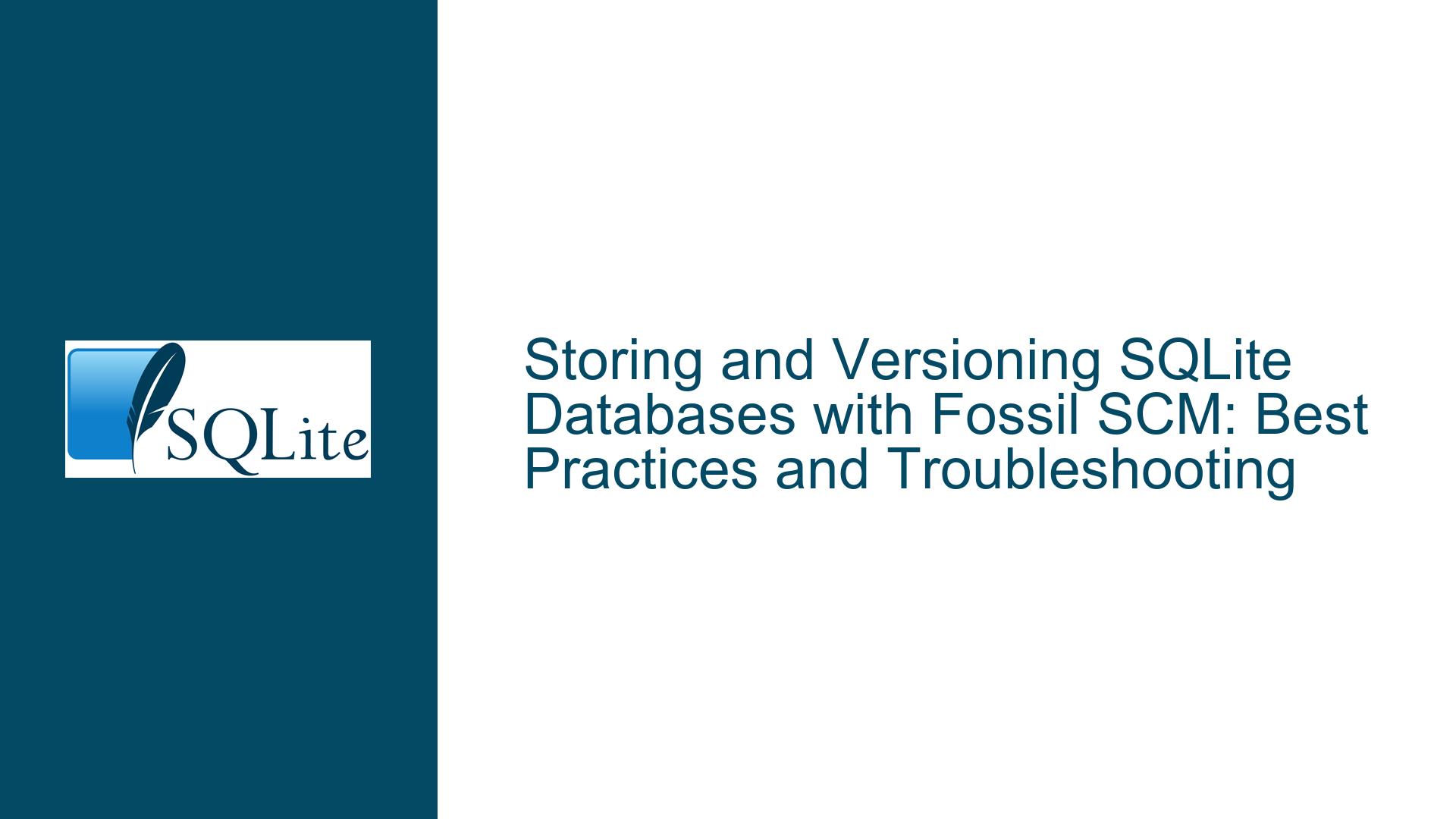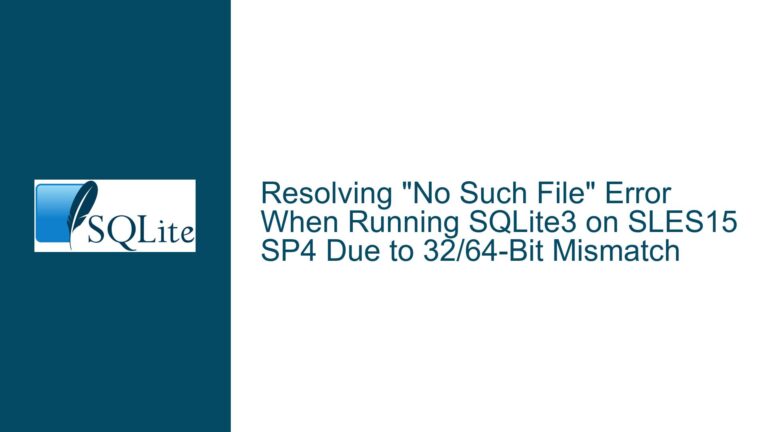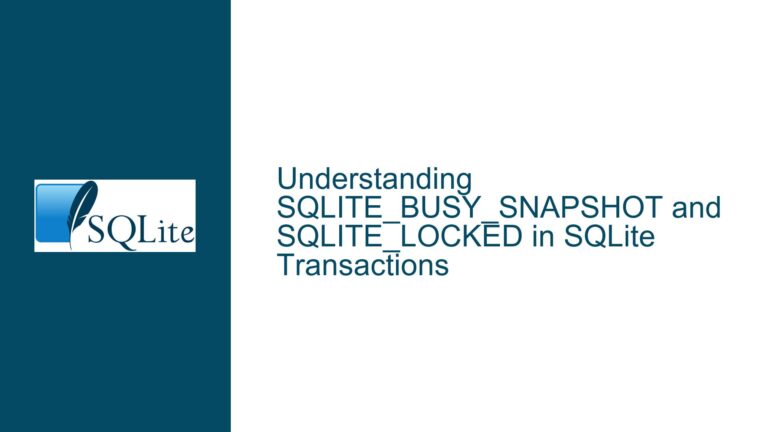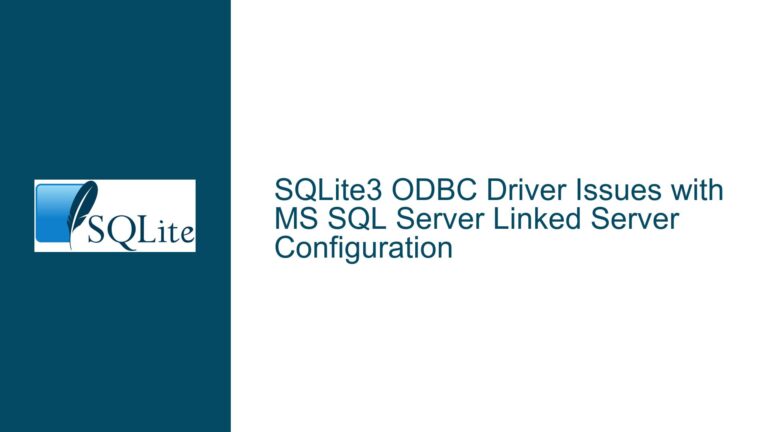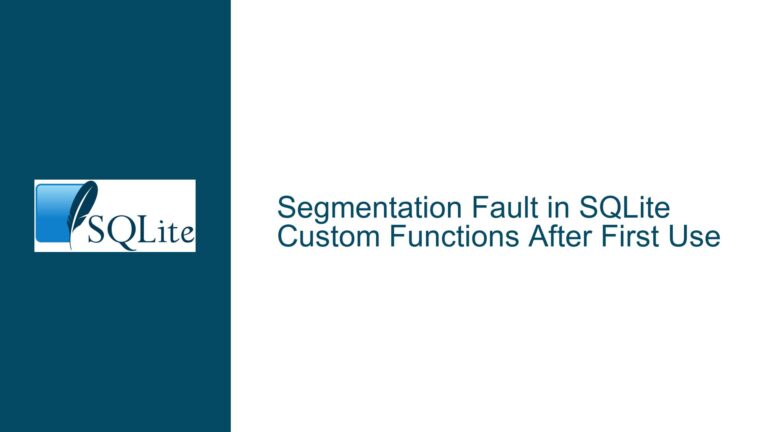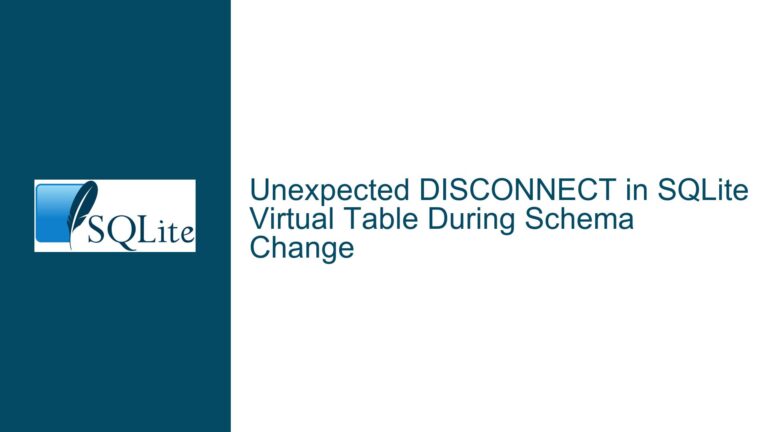Storing and Versioning SQLite Databases with Fossil SCM: Best Practices and Troubleshooting
Issue Overview: Storing SQLite Database History with Fossil SCM
The core issue revolves around the challenge of effectively storing and versioning SQLite database files using Fossil SCM, a distributed version control system that itself uses SQLite as its backend. The primary concern is how to manage the binary nature of SQLite database files within a version control system designed to handle text-based changes efficiently. The discussion highlights several approaches, including storing the SQL text output from the .dump command, separating schema and data into different files, and using compression techniques to minimize repository size. Additionally, there is a focus on managing large databases with frequent changes, where the goal is to archive only the changes (deltas) rather than the entire database to save storage space.
The problem is multifaceted, involving considerations such as:
- The binary nature of SQLite files and their incompatibility with text-based version control systems.
- The need for efficient storage and retrieval of database changes over time.
- The desire to maintain a human-readable format for schema and data changes, enabling easy review and debugging.
- The challenge of handling large databases with frequent updates, where storing full database dumps is impractical due to storage constraints.
The discussion also touches on the limitations of existing tools and the potential for custom solutions, such as enhancing the .dump command to support ordered output or using triggers to track changes within the database itself. These approaches aim to strike a balance between maintaining a complete history of the database and minimizing the storage overhead associated with version control.
Possible Causes: Why Storing SQLite Databases in Fossil SCM is Challenging
The challenges of storing SQLite databases in Fossil SCM stem from several inherent characteristics of both SQLite and version control systems. Understanding these causes is crucial for developing effective solutions.
Binary File Format of SQLite Databases: SQLite databases are stored in a binary format, which is not well-suited for version control systems like Fossil SCM that are optimized for text-based files. Binary files do not lend themselves to efficient delta compression, which is a key feature of version control systems for minimizing storage requirements. This limitation makes it difficult to track changes in the database over time without storing entire copies of the database file.
Lack of Native Support for Ordered Dumps: The
.dumpcommand in SQLite outputs the database schema and data as SQL text, which can be stored in a version control system. However, the default output of.dumpdoes not guarantee a consistent order of rows, especially forINSERTstatements. This inconsistency complicates the process of tracking changes, as even minor modifications can result in large diffs due to reordering of rows. A predictable order would allow Fossil SCM’s delta compression to work more effectively, reducing repository size.Handling Large Databases with Frequent Changes: For large databases that undergo frequent updates, storing full database dumps is impractical due to the rapid growth of the repository. The discussion highlights the need for a mechanism to store only the changes (deltas) between database states, rather than the entire database. This approach would significantly reduce storage requirements but requires a reliable method to generate and apply these deltas.
Separation of Schema and Data: The schema (structure) of a database and its data (content) often have different versioning requirements. While schema changes are typically infrequent and require careful review, data changes can be frequent and voluminous. Storing schema and data separately allows for more granular control over versioning but introduces complexity in managing the relationship between the two.
Compression and Repository Size: Fossil SCM applies compression to committed artifacts, but pre-compressing data before committing can lead to inefficient storage. This is particularly relevant when dealing with binary files or already compressed formats, as further compression may not yield significant savings and can even increase repository size due to redundant compression attempts.
Custom Solutions and Tool Limitations: Existing tools like
.dumpandsqlitediffprovide some functionality for generating and comparing database states, but they may not fully meet the needs of users looking to version control their databases. Custom solutions, such as using triggers to track changes or enhancing the.dumpcommand, require additional development effort and may introduce new complexities.
Troubleshooting Steps, Solutions & Fixes: Effective Strategies for Versioning SQLite Databases with Fossil SCM
To address the challenges of storing and versioning SQLite databases with Fossil SCM, several strategies and solutions can be employed. These approaches aim to optimize storage, maintain a clear history of changes, and ensure that the database can be reconstructed accurately at any point in time.
Using
.dumpfor Text-Based Storage: One of the most straightforward solutions is to use the.dumpcommand to export the database schema and data as SQL text. This text-based representation can then be stored in Fossil SCM, allowing for efficient version control. To improve the effectiveness of this approach, consider sorting theINSERTstatements in the dump file. Sorting ensures that changes to the data are more easily detectable by Fossil SCM’s delta compression, as the order of rows remains consistent across versions. Tools like Visual Studio Code can be used to sort theINSERTstatements, or custom scripts can be developed to automate this process.Separating Schema and Data: Storing the schema and data in separate files can provide greater flexibility in version control. The schema, which defines the structure of the database, can be stored in a
schema.sqlfile, while the data can be stored in adata.sqlfile or even in CSV format for large datasets. This separation allows for more granular control over versioning, as schema changes can be reviewed and committed independently of data changes. Additionally, it simplifies the process of reconstructing the database, as the schema can be applied first, followed by the data.Implementing Change Tracking with Triggers: For databases with frequent updates, implementing triggers to track changes can be an effective solution. Triggers can be set up to log inserts, updates, and deletes to a separate history table. This history table can then be versioned using Fossil SCM, providing a detailed record of changes over time. While this approach requires additional setup and maintenance, it offers a more efficient way to track changes compared to storing full database dumps. However, it is important to note that DDL (Data Definition Language) commands, which modify the schema, would need to be tracked separately.
Using
VACUUM INTOandsqlitedifffor Incremental Backups: For large databases, storing full dumps on a regular basis may not be feasible due to storage constraints. Instead, consider using theVACUUM INTOcommand to create periodic checkpoints of the database. These checkpoints can then be compared using thesqlitedifftool to generate deltas, which represent the changes between checkpoints. These deltas can be stored in Fossil SCM, significantly reducing storage requirements. While this approach may be slower than other methods, it provides a reliable way to maintain a history of changes without storing full database copies.Customizing the
.dumpCommand: If the default behavior of the.dumpcommand does not meet your needs, consider customizing it to produce output in a more predictable order. This could involve modifying the SQLite CLI source code to add options for controlling the order ofINSERTstatements, or writing custom scripts to process the output of.dumpand reorder the statements as needed. A predictable order ensures that Fossil SCM’s delta compression can work more effectively, minimizing repository size.Optimizing Compression for Fossil SCM: Fossil SCM applies compression to committed artifacts, but pre-compressing data before committing can lead to inefficient storage. To avoid this, ensure that the data being committed is not already in a compressed format. For example, avoid committing PNG files or other compressed formats directly. Instead, store the data in an uncompressed format and let Fossil SCM handle the compression. This approach maximizes the effectiveness of Fossil’s delta compression and helps keep the repository size manageable.
Archiving Monthly and Daily Changesets: For databases that change frequently, consider implementing a strategy that involves archiving monthly base dumps and daily changesets. The monthly base dump represents the state of the database at the beginning of the month, while the daily changesets capture the changes made each day. To reconstruct the database for a specific day, apply the monthly base dump followed by the relevant daily changesets. This approach significantly reduces storage requirements, as only the base dump and the changesets need to be stored, rather than full daily dumps. Tools like
sqlitediffcan be used to generate the changesets, or custom scripts can be developed to automate the process.Exploring Alternative Backup Strategies: In some cases, traditional version control systems may not be the best fit for managing database changes. Consider exploring alternative backup strategies, such as using the
dumputility from Unix systems, which is designed for incremental backups. This utility can be adapted to work with SQLite databases, providing a reliable way to generate and apply changesets. While this approach may require more effort to set up, it offers a robust solution for managing large databases with frequent changes.Leveraging Fossil SCM’s Delta Compression: Fossil SCM’s delta compression algorithm is highly effective at minimizing repository size by storing only the differences between versions of a file. To take full advantage of this feature, ensure that the files being committed are in a format that allows for efficient delta compression. For SQLite databases, this means using text-based formats like the output of
.dumprather than binary formats. Additionally, sorting theINSERTstatements in the dump file ensures that changes are more easily detectable, further optimizing delta compression.Monitoring Repository Size and Performance: As you implement these strategies, it is important to monitor the size of your Fossil SCM repository and the performance of your version control operations. Large repositories can become unwieldy and slow to work with, so regularly review your storage practices and make adjustments as needed. Consider setting up automated scripts to generate and apply changesets, and periodically clean up old backups to free up storage space.
By carefully considering these strategies and tailoring them to your specific needs, you can effectively store and version SQLite databases using Fossil SCM. Whether you choose to use .dump for text-based storage, implement triggers for change tracking, or explore alternative backup strategies, the key is to strike a balance between maintaining a complete history of your database and minimizing storage overhead. With the right approach, you can ensure that your database is both version-controlled and efficiently managed, providing a reliable foundation for your applications and workflows.
